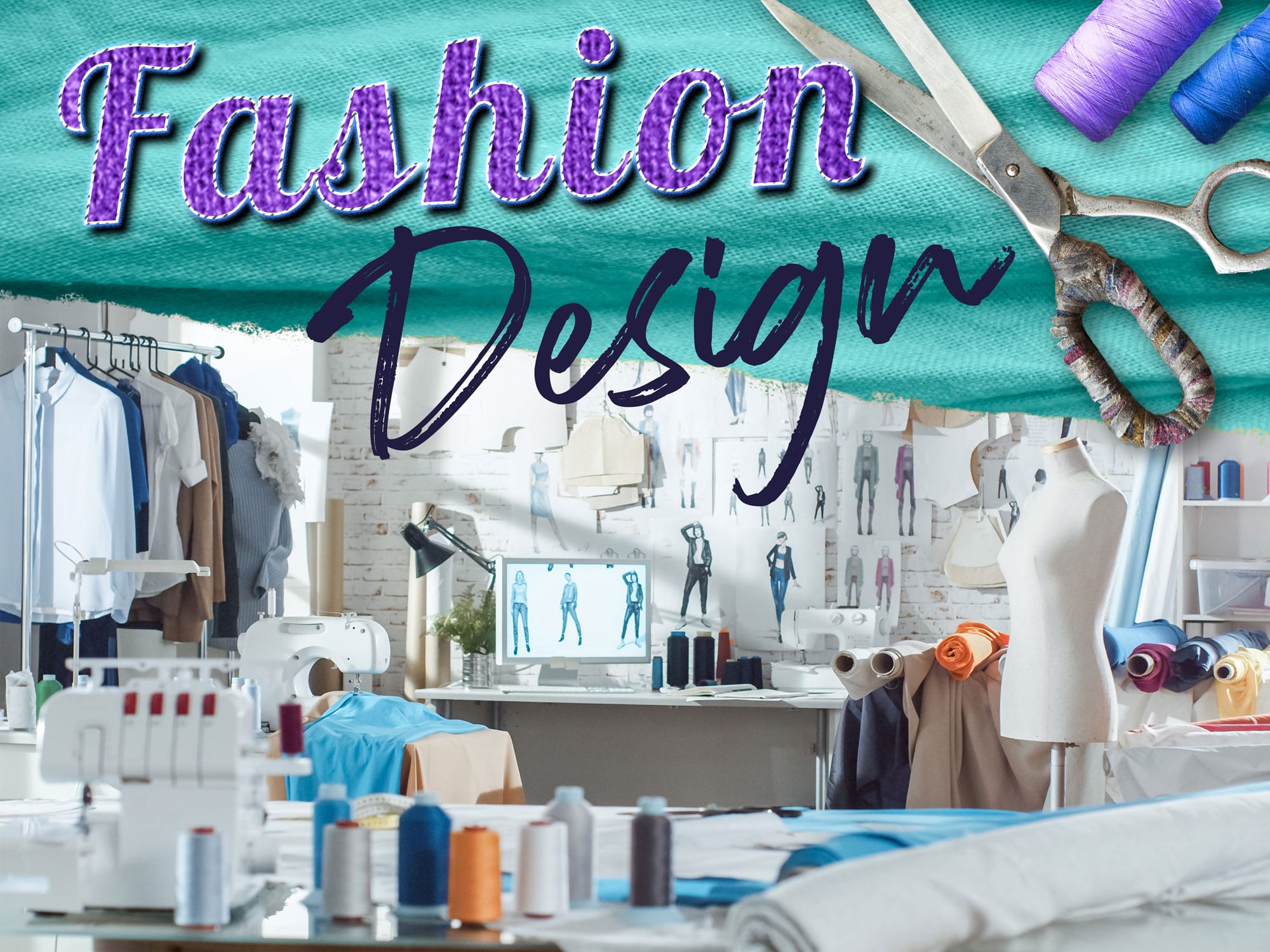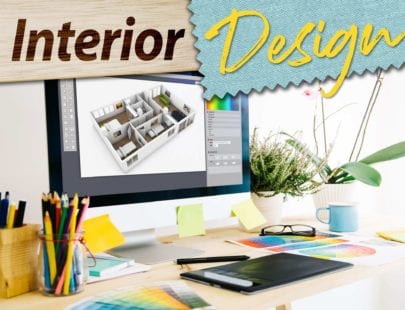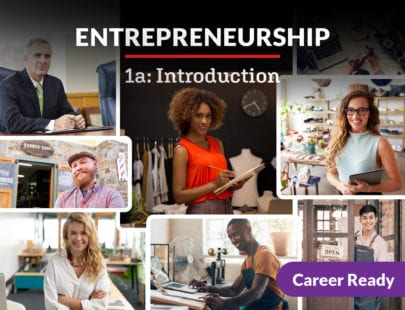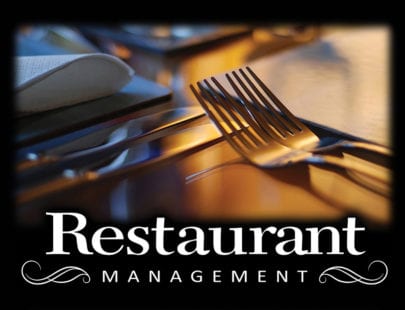
Fashion Design
Are you a fashion trend follower? Are you drawn to how designers have pulled together fabrics and colors to create memorable pieces? Do you dream of designing your own line of clothing or accessories? Learn what it takes to get started in the fashion industry, from the careers available to new technology and trends reshaping the industry every day. Start creating!
Units at a Glance
Unit 1: Introducing: Fashion Careers
If you have always had a flair for fashion, there are several ways for you to turn this into a career. While staying on top of trends and having a knack for putting together that killer outfit are definitely part of a career in fashion design, there is a lot more to it than that. While these talents help, most careers in fashion require great communication skills as well as a strong sense of style because helping people express themselves through design and color requires a lot of listening. Let’s get to know some of the careers in fashion design and what it takes to prepare for them.
What will you learn in this unit?
- Describe careers in the fashion industry
- Classify careers from entry to professional level
- Explore entrepreneurship opportunities in the design industry
- Research and present information on design careers
Unit 2: Design and Communicate: Basic Skills for the Design Industry
It’s time to start learning the language of design. No worries—we don’t need to become fluent in French to function in fashion! Instead, we’ll explore the elements of design—such as texture and form and the principles of design, including balance and rhythm—and apply them to various color schemes. But once we’ve learned how to speak the language of the runway, how do we communicate our visions to others? Turns out we can learn a few quick communication tips that help us “translate” our ideas into reality!
What will you learn in this unit?
- Define the elements and principles of design
- Create a color wheel
- Understand the psychology of color
- Distinguish between non-assertive, assertive, and aggressive communication
- Practice active listening skills
- Explain what an informational interview is and how best to conduct one
Unit 3: Physical Tools for Fashion Designers
Did you ever think you might need a tool that looks like a tiny pizza cutter when designing an outfit? You might! We’ll explore why. Let’s take a critical look at the instruments, aids, and software that many design professionals use. You’ll learn how and why designers use these tools, and you’ll consider which ones may be worth your time and money. You’ll also find out about one of the most important components of almost any designer’s workspace: fabric.
What will you learn in this unit?
- Identify and select appropriate tools and equipment for a variety of projects
- Explain proper care and maintenance of equipment
- Distinguish between a variety of fabrics and explain some of their uses and qualities
- Describe how different types of software can help someone in the field of fashion design
Unit 4: Sewing 101
It’s time to sew! Whether you already have lots of experience or this is your first project ever, you will improve your skills and learn a great deal. Get ready to learn what the parts of a sewing machine are and what these machines can do. Along the way, you’ll also find out about a simple alternative to sewing machines—a simple needle in your hand.
What will you learn in this unit?
- Demonstrate various stitches, either by hand, on a machine, or both
- Identify the parts of a sewing machine and explain their purposes
- Select the appropriate type of stitch for a project
- Prepare fabric before sewing so that results look neat and professional
Unit 5: Choosing Clothing
Have you ever carefully selected (or created) clothing for a big event, only to feel that the outfit didn’t make quite the impression you had hoped for? In this unit, you’ll learn the secrets of choosing the right clothing. You’ll discover where trends often begin and how they spread. You’ll learn about which types of clothing are considered “appropriate” for which occasions, and then you’ll decide whether to obey or ignore those rules.
What will you learn in this unit?
- Explain how trends catch on, spread, and then fade
- Select appropriate clothing styles for business, casual, and formal occasions
- Describe how body type and garment fit can affect the impression an ensemble makes
- Demonstrate the procedure for recording accurate body measurements
Unit 6: The Runway Gives Back
“Ugh, people who care about fashion are so shallow,” you may have heard someone complain. “They only think about looking good.” In this unit, we explode this stereotype by describing how the fashion industry has become more inclusive of individuals and a better steward of environmental resources. We’ll enter the world of sustainable fashion. We’ll learn what social entrepreneurship is and what unintended consequences it sometimes has. We’ll find out specific ways in which designers and manufacturers have reached out to people who have special needs or disabilities. And we’ll learn how you can develop your leadership and public relations skills so that you can give back to your community. The information in this unit can change how you see the world and help you develop skills that you’ll use for the rest of your life.
What will you learn in this unit?
- Explain what sustainable fashion is and why it is becoming more popular
- List the advantages and possible pitfalls of social entrepreneurship
- Describe the ways in which fashion has become more welcoming to people who have special needs or disabilities
- Identify leadership qualities to develop while giving back to the community
- Develop public relations skills when reaching out to the wider world
- Differentiate between environments with barriers and environments with barrier-free design
Unit 7: Putting It into Practice
Are you ready to show off? It’s time to create an outfit and demonstrate your understanding of the fashion industry by considering many of its aspects, including cost, market, and production. Making at least one piece of the outfit yourself will help you further develop your sewing or accessory design skills. You will wear many hats: not only designer but also planner, artist, craftsperson, budgeter, and presenter. When you have finished, you may have one or more pieces that could go in your portfolio if you are seeking an internship or entry-level position.
What will you learn in this unit?
- Define a project’s occasion, production, budget, and market
- Brainstorm ideas, select the best ones, and turn them into labeled sketches
- Create and adjust a budget based on needs and wants
- Prepare fabric and either construct or adapt a garment or accessory
- Present the completed ensemble and reflect on what you have learned
Unit 8: Entrepreneurship: Ready for Business
So much of your schooling has had to do with showing teachers that you understand what they have taught you. What about your working life? How will you show that you are an excellent job candidate? And once you land the job, how will you show that you work hard, collaborate well with others, are trustworthy, and regularly deliver what you promise? It’s time to learn about entrepreneurship, resumes, portfolios, and teamwork. The work you do in this unit can help you in your future jobs and careers. You’ll find out how to present yourself in the best possible light so potential employers and clients can understand your skills, talents, and interests.
What will you learn in this unit?
- Follow the rules of ethical conduct, confidentiality, and giving proper credit
- Improve skills in time management and teamwork
- Determine what to put in a resume and what to leave out
- Differentiate between types of portfolios
- Begin searching for jobs online
- Analyze modern trends in the design industry, such as 3D and 4D printing
Required Materials
Physical
- art supplies, such as paper, pens, colored pencils, paints, tape, glue, scissors, poster board, and markers
- sewing machine (can be electronic programmable, straight stitch, zigzag, or old-style machine; should have tension adjustment controls)
- thread
- fabric
- pattern
- pattern tools to mark on fabric, such as tailor’s chalk or pen with disappearing ink
- needle and thread for hand sewing
- measuring tape or yardstick
- raw materials to either create or modify a garment or accessory, such as fabric, buttons, and other components
- if necessary, methods to clean material, such as a dry-cleaning service, washing machine, detergent, or supplies for hand washing
- if necessary, methods to press or iron material, such as an iron, ironing board, and possibly a pressing cloth
Software
- word processing software
- slide presentation software
Other
- person who works in the fashion industry to interview
Optional
- software that allows the creation of simple art projects, such as Photoshop or Canva
- software such as Illustrator, Photoshop, or Procreate
- notebook
- phone camera or other digital camera
- audio recording device
- video recording device
- images from magazines
- index cards
- computer printer
- iron
- light box
- embroidery floss or yarn
- print fashion magazines
- calculator (can be a phone-based or web-based calculator rather than a separate device)
- if necessary, methods to clean material, such as a dry-cleaning service, washing machine, detergent, or supplies for hand washing
- if necessary, methods to press or iron material, such as an iron, ironing board, and possibly a pressing cloth
- a portfolio case, binder, or other way to assemble and organize physical samples
- a website or online portfolio account where you can create a digital portfolio



